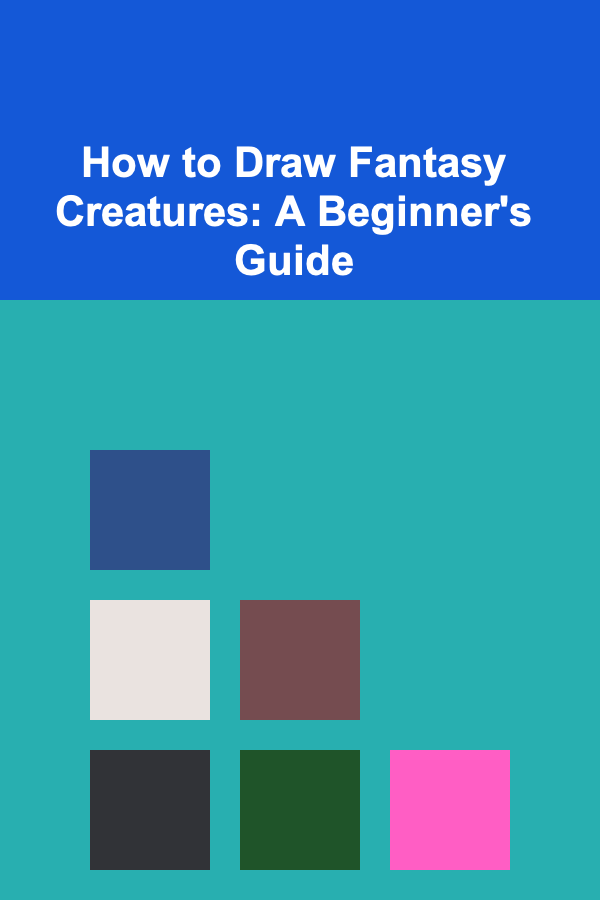
How to Draw Fantasy Creatures: A Beginner's Guide
ebook include PDF & Audio bundle (Micro Guide)
$12.99$7.99
Limited Time Offer! Order within the next:

Drawing fantasy creatures can be an exhilarating and imaginative experience. The process allows you to explore your creativity and push the boundaries of your artistic abilities. Whether you're an aspiring illustrator or just someone who enjoys drawing for fun, creating your own fantastical beings can be both challenging and deeply rewarding.
In this guide, we'll walk you through the essentials of drawing fantasy creatures, offering tips, techniques, and exercises to help you improve your skills. Whether you're interested in drawing dragons, fairies, or entirely original creations, this article will provide you with the knowledge you need to bring your ideas to life.
Step 1: Understanding Fantasy Creatures
Before you begin drawing, it's crucial to understand the different types of fantasy creatures and the characteristics that make them unique. Fantasy creatures can come in various shapes, sizes, and forms. They are typically born from myths, folklore, and the imagination, often combining elements of animals, humans, and otherworldly traits. Here are a few categories of fantasy creatures to inspire your drawings:
Dragons
Dragons are perhaps the most iconic fantasy creatures, appearing in countless mythologies, books, movies, and games. They are often depicted as large, winged reptiles, but their appearance can vary widely. Some are serpentine, while others have multiple heads, horns, or elemental powers. Understanding how to draw dragons involves grasping their anatomy, proportions, and the way their various features interact.
Fairies and Elves
Fairies and elves are creatures of elegance and magic. Fairies are often depicted as small, delicate beings with wings, while elves are typically taller and have human-like characteristics. Both creatures are known for their ethereal beauty and are often associated with nature, magic, and mystical realms. To draw them effectively, focus on anatomy, symmetry, and lightness in their features.
Monsters
Fantasy monsters can take many forms, from terrifying beasts to humorous, quirky characters. Their anatomy is often exaggerated for dramatic effect, allowing for a lot of freedom in your designs. Whether they have multiple limbs, strange facial features, or bizarre proportions, monsters are a great opportunity to explore unconventional designs.
Hybrid Creatures
Hybrid creatures are a mix of two or more animals or beings, such as the griffin (half lion, half eagle) or the centaur (half human, half horse). These creatures require a deep understanding of anatomy to ensure that the different parts blend together naturally. Studying animal anatomy and human proportions is essential when drawing hybrids.
Step 2: Mastering the Basics of Drawing
Before you can bring fantastical creatures to life, it's important to master the basics of drawing. These fundamental skills will form the foundation of your more advanced illustrations.
1. Anatomy and Proportions
Fantasy creatures often involve a mix of human, animal, or even entirely new forms. Understanding anatomy and proportions is crucial for making your creature designs believable. Even if your creatures are completely imaginary, a solid understanding of how bones, muscles, and joints work will help you make more dynamic and realistic creatures.
2. Gesture Drawing
Gesture drawing is the practice of quickly sketching the basic pose or movement of a subject. It's crucial for capturing energy and motion in your creatures. Spend time doing quick sketches of animals or human figures to get a feel for how bodies move and shift. This will help you bring your fantasy creatures to life in dynamic ways.
3. Light and Shadow
Light and shadow are key components of creating depth and dimension in your artwork. Understanding how light falls on an object (or creature) is essential for making it look three-dimensional. Practice shading simple shapes like spheres and cubes before you move on to more complex forms like dragons or monsters.
4. Textures and Details
Fantasy creatures often have unique textures, such as scaly skin, fur, feathers, or horns. Experiment with different shading techniques to create these textures. For example, use small, quick strokes for fur, and larger, flowing lines for scales. Detailing your creatures will add realism and intrigue to their design.
Step 3: Drawing Your First Fantasy Creature
Now that you've covered the basics, it's time to start drawing! Below is a step-by-step guide to drawing your first fantasy creature. We'll go over the process of drawing a dragon, but the principles apply to any creature you wish to create.
1. Start with Basic Shapes
Begin by sketching the basic shapes of your creature. Dragons, for example, might start as a series of circles and ovals to represent the head, body, and limbs. These shapes are the foundation for your creature, and they'll help you establish its proportions and pose.
2. Draw the Head and Body
Using the basic shapes, start defining the head and body. The head might consist of a larger oval with a snout, while the body can be drawn as an elongated shape, adding more curves or angles based on your creature's design. For dragons, you might want to emphasize the long neck and tail. Keep the proportions in mind as you sketch out the body---dragons are often depicted with large, muscular bodies, while fairies might have delicate, slender torsos.
3. Add Limbs and Wings
Next, sketch the limbs or wings of your creature. For dragons, the wings might emerge from the back, with large, bat-like membranes. If you're drawing an elf or fairy, you'll likely want to focus on slender, graceful limbs. Pay attention to how the limbs are connected to the body and try to keep them anatomically correct.
4. Outline the Features
Once you're happy with the basic shape and structure, start defining the features of your creature. For a dragon, you can start adding details like the eyes, horns, scales, and claws. For a fairy, focus on delicate facial features, wing details, and hair. Elves may have pointed ears and sharp, angular features. As you outline these features, be mindful of the symmetry and style you want to achieve.
5. Add Details and Textures
Now it's time to add details that will make your creature come to life. For a dragon, you can add scales, spines, and texture to the wings. For a fairy, you might add intricate designs to the wings or flowy hair. This is where you can really let your imagination run wild and give your creature its own personality.
6. Shading and Lighting
Shading is key to making your fantasy creature look three-dimensional. Determine where the light source is coming from, and then shade the areas that would be in shadow. For example, the underside of the dragon's wings and belly might be darker, while the top of the creature would have highlights.
7. Final Touches
Finally, go over your drawing and make any necessary adjustments. Add small details like textures, highlights, and shadows. You can also use an eraser to create highlights on the creature's skin or scales to give it a polished look.
Step 4: Experiment with Different Creatures
As you become more comfortable with drawing, try experimenting with different types of fantasy creatures. Here are some ideas to inspire your next project:
1. Sea Creatures
Imagine a creature that lives underwater---perhaps a hybrid between an octopus and a fish, with long flowing fins and glowing bioluminescent spots. Experiment with different textures, such as smooth, wet skin, or rough, barnacle-covered armor.
2. Forest Guardians
Create a creature that protects a magical forest. It could have the body of a bear with the antlers of a deer, covered in leaves and moss. Play around with natural elements to blend your creature into its environment.
3. Alien Lifeforms
Design a creature from another planet. It might have multiple limbs, an asymmetrical face, or even strange, otherworldly appendages. Don't be afraid to push the boundaries of anatomy and design.
4. Mythological Beasts
Draw inspiration from mythological creatures such as the Chimera, Cerberus, or Medusa. These creatures often combine multiple animal traits, creating the perfect opportunity for you to practice blending anatomy and adding unique details.
Step 5: Practice, Practice, Practice
The key to improving your drawing skills is practice. The more you draw, the better you'll become at understanding anatomy, proportions, and the finer details that make a fantasy creature unique. Take your time and experiment with different styles, poses, and expressions.
Here are some exercises to help you improve:
- Daily Sketches: Draw a new fantasy creature every day, focusing on different aspects such as texture, anatomy, and poses.
- Creature Design Challenges: Participate in online drawing challenges or set your own. These often involve creating a new creature based on specific prompts or themes.
- Study Other Artists: Look at the work of other artists who specialize in fantasy creatures. Analyze their techniques and use them as inspiration for your own designs.
Conclusion
Drawing fantasy creatures is a fun and imaginative process that allows you to explore your artistic abilities. By mastering the fundamentals of anatomy, gesture drawing, and shading, you'll be able to create detailed, believable creatures. Experimenting with different styles, textures, and poses will help you develop your own unique approach to fantasy art. With practice and patience, you'll be able to bring your wildest creatures to life on paper. Happy drawing!
Reading More From Our Other Websites
- [Personal Care Tips 101] How to Apply Sunscreen Without Clogging Pores
- [Sewing Tip 101] Mastering the Seam: A Step‑by‑Step Guide to Sewing Zippers Like a Pro
- [Organization Tip 101] How to Establish a Family Command Center
- [Reading Habit Tip 101] How to Build a Year-Long Reading Habit Without Burning Out
- [Toy Making Tip 101] Eco-Friendly Plush: Sustainable Fabrics and Fillings for Green Toy Makers
- [Hiking with Kids Tip 101] Leave No Trace Together: Teaching Children Proper Hiking Etiquette
- [Home Family Activity 101] How to Elevate Your Family "Restaurant" Night at Home with Themed Menus and Decor
- [Home Budget Decorating 101] How to Create a Beautiful Home Office on a Budget
- [Home Family Activity 101] How to Create a DIY Family Art Project That Celebrates Your Bond
- [Scrapbooking Tip 101] DIY Holiday Scrapbook Pages: Step‑by‑Step Guides for Every Season

How to Create a Lease Agreement That Protects Both Parties
Read More
How to Protect Your Rental Property with Proper Insurance
Read More
How to Use Binder Systems for Craft Patterns and Ideas
Read More
How to Make Smart Financial Decisions: A Comprehensive Guide
Read More
How to Choose the Right Martial Art for Your Body Type
Read More
How to Assess and Address Food Insecurity in Your Community
Read MoreOther Products

How to Create a Lease Agreement That Protects Both Parties
Read More
How to Protect Your Rental Property with Proper Insurance
Read More
How to Use Binder Systems for Craft Patterns and Ideas
Read More
How to Make Smart Financial Decisions: A Comprehensive Guide
Read More
How to Choose the Right Martial Art for Your Body Type
Read More